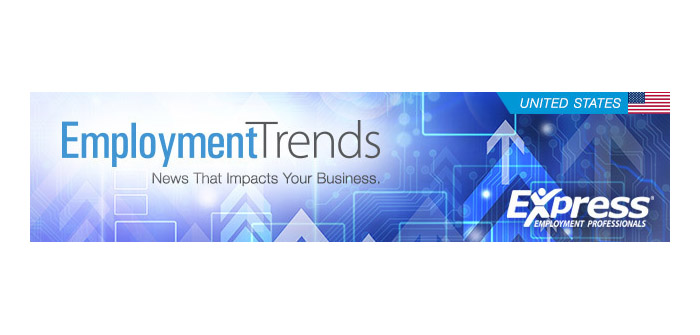Unemployment Rate 3.6 Percent
The U.S. economy added 390,000 nonfarm jobs in May, as unemployment was unchanged at 3.6 percent. The Leisure and Hospitality industry had the largest increase in employment in the private sector, adding 84,000 positions, while Government jobs increased by 57,000.
Learn more from the recent employment report compiled by the U.S. Bureau of Labor Statistics and view the unemployment rate in your state.
Major Industry Employment:
- Construction: + 36,000
- Manufacturing: + 18,000
- Retail Trade: – 60,700
- Transportation and Warehousing: + 47,000
- Information: + 16,000
- Professional and Business Services: + 75,000
- Education and Health Services: + 74,000
- Health Care and Social Assistance: + 42,100
- Leisure and Hospitality: + 84,000
- Government: + 57,000
Question of the Month
How Have High Gas Prices Impacted Your Daily Commute?
Answer Now
Workforce
47 percent of U.S. Employees Forced to Self-Train Due to Lack of Knowledge Transfer from Retiring Employees
ExpressPros.com – May 25, 2022
As senior employees prepare to exit the workforce, 84 percent of U.S. employees say it’s a big loss when older employees retire without passing on their years of knowledge to younger employees. And when the transfer of knowledge fails to happen, workers can be left learning how to do a job on their own, with nearly half of U.S. employees (47 percent) experiencing this, according to a recent survey from The Harris Poll commissioned by Express Employment Professionals.
In the workplace, baby boomers are more likely than their younger counterparts to feel knowledgeable (66 percent vs. 49 percent — 57 percent), and this is reiterated by younger employees who say they view boomers in the workplace as having valuable knowledge (61 percent), people they can learn a lot from (48 percent) and as role models to look up to (43 percent).
Most U.S. employees (73 percent) say it’s absolutely essential or very important for employees to share the knowledge needed to perform their job responsibilities with others. Encouragingly, the majority (66 percent) believe their employer is taking the right steps to make sure they don’t experience a “brain drain” (i.e., when older employees retire without sharing knowledge of how to do their job with younger generations).
Read More
Reaching Diverse Candidates is One of the Biggest Hiring Challenges for 1 in 5 Companies
ExpressPros.com – June 8, 2022
Efforts to establish a company diversity, equity and inclusion (DEI) policy have steadily increased over the last two years, but 21 percent of U.S. companies say translating this effort to hiring is one of the biggest hiring challenges their company will face over the next year, according to a recent survey from The Harris Poll commissioned by Express Employment Professionals.
Fifty-four percent of businesses report having a DEI policy in place, compared to 52 percent in the first half of 2021 and 46 percent in the second half of 2020. Looking to the future, nearly a fifth of hiring decision-makers (18 percent) say their company plans to implement such a policy. Of those planning to do so, 11 percent say they plan to implement one by the end of 2022.
Given companies’ establishment of DEI policies, the likely next step is to actively recruit candidates outside of the companies’ traditional demographic (e.g., have unique backgrounds, racially/ethnically diverse).
Around half (49 percent), say their company is planning to take such action in 2022-in line with 2021 (51 percent). To this point, a fifth of U.S. hiring decision-makers (21 percent) say reaching these diverse candidates is one of the biggest hiring challenges their company will face over the next year. This is particularly a struggle in manufacturing industries (39 percent).
“It’s encouraging to see more companies adopting diversity, equity and inclusion policies to create workforces reflective of our society,” Express Employment International CEO Bill Stoller said. “Everyone deserves to feel heard and represented in their career as part of collaborative company cultures.”
Read More
Staffing
Temporary Employment Up Year Over Year
Staffing Industry Analysts – June 16, 2022
In the first three months of the year, the staffing industry has added 2.7 million jobs, signaling a strong year for temporary and contract positions. According to the American Staffing Association, the gains in the first quarter of the year represent a 1.6 percent increase compared to Q1 2021.
Historically, the staffing industry experiences gains in the final three months of the year, followed by a decrease during the first quarter. Compared to Q4 of 2021, temporary positions were down 197,000, or 6.7 percent, in the first quarter of 2022.
“The staffing and recruiting industry continues to support job creation and economic growth,” said Richard Wahlquist, ASA president, and CEO. “In this challenging hiring climate, staffing companies are crucial players in providing flexibility and meeting the labor demands of companies looking to fill their full-time and flexible talent benches.”
Business
Employment Trends Index Decreased in May
The Conference Board – June 6, 2022
After slightly decreasing in April, The Conference Board Employment Trends Index (ETI) continued to drop in May to 119.77, down from an upwardly revised reading of 120.60 in April. The decrease can be attributed to negative readings from four out of eight index components: “the Percentage of Respondents Who Say They Find ‘Jobs Hard to Get,’” “Ratio of Involuntarily Part-time to All Part-time Workers,” “Real Manufacturing and Trade Sales” and “Industrial Production.”
“The Employment Trends Index fell slightly in May, signaling slowing, but positive job growth in the months ahead. The labor market may have less room for more growth with overall employment down only 0.5 percent compared to the pre-pandemic level,” said Agron Nicaj, Associate Economist at The Conference Board. “However, leisure and hospitality and in-person services industries have yet to fully recover job losses incurred since the pandemic. Employment growth is still expected in these industries as consumers continue to shift more spending away from goods and towards services.”
Consumer Confidence Decreases in May
The Conference Board – May 31, 2022
After a nominal gain in April, U.S. consumer confidence dropped in May. The Conference Board’s Consumer Confidence Index decreased from an upwardly revised reading of 108.6 in April to 106.4 in May. The short-term outlook of consumers increased as the Expectations Index was down from 79.0 in April to 77.5 in May. The Present Situation Index, which shows current views on business and labor conditions, was down from 152.9 in April to 149.6 in May.
The report also found that 51.8 percent of respondents felt jobs were currently plentiful, down from 54.8 percent in April, while the amount of those who said jobs were hard to get was up from 10.1 percent in April to 12.5 percent in May.
“Consumer confidence dipped slightly in May, after rising modestly in April,” said Lynn Franco, Senior Director of Economic Indicators at The Conference Board. “The decline in the Present Situation Index was driven solely by a perceived softening in labor market conditions. By contrast, views of current business conditions—which tend to move ahead of trends in jobs—improved.”
Economy
U.S. Inflation Highest Since December 1981
Wall Street Journal – June 10, 2022
After experiencing a slight decrease from 8.5 percent in March to 8.3 percent in April, the U.S. inflation rate jumped to its highest level in more than four decades, affected by higher energy and food prices. According to the Labor Department, the consumer price index (CPI), which measures what consumers pay for goods and services, increased by an annual rate of 8.3 percent in April to 8.6 percent in May. Month-over-month, the CPI increased 1 percent in May compared to a 0.3 percent increase in April. Energy prices rose 34.6 percent, while grocery prices rose 11.9 percent in May.
Core prices, which exclude volatile categories like food and energy, increased 0.6 percent, up from the 0.2 percent month-over-month average pre-pandemic. On an annual basis, the core price index was up 6 percent in May, down slightly from 6.2 percent in April.
Before pandemic-related issues and higher government spending, inflation was at 1.8 percent in 2019, below the 2 percent goal of the Federal Reserve. However, when the new administration took office in January 2021, inflation sat at 1.4 percent.





